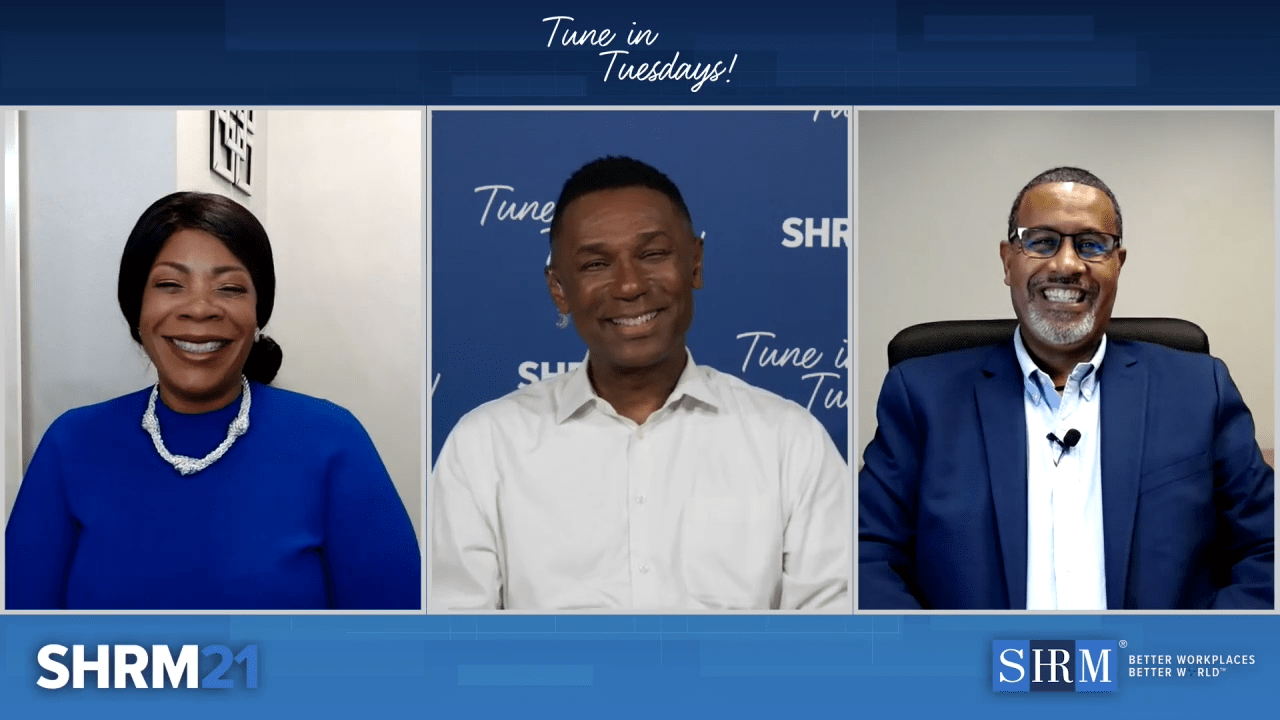
Uncovering unconscious biases and gathering data to prove the need for action are key to making changes in the workplace, members of the new Blue Ribbon Commission on Racial Equity said yesterday during a webcast on their work.
The 13-member commission was created by the Society for Human Resource Management (SHRM) and held its first meeting Aug. 28. Two members who are also SHRM volunteer leaders spoke with SHRM President and CEO Johnny C. Taylor, Jr., SHRM-SCP, on SHRM's Sept. 8 Tune in Tuesday show about the group's priorities and objectives.
Their first task will be to define diversity. "So many people are stuck on the things you see, but there's also thought diversity," said Trisha Zulic, SHRM-SCP, director of human resources, business operations and strategy for WSA Distributing, Inc. in San Diego. She added that gender and age discrimination are also big issues in the workplace. "We have a lot of work to do to really define what that looks like."
Jason Lawson, vice president for human resources at Installed Building Products in Columbus, Ohio, agreed, but at the same time cautioned that the initial work of the commission should stay focused on race. "Right now, we're dealing with a house on fire, and that house happens to be racial diversity," he said. "If you try and take on 10 different things, none of them is going to get done well."
Taylor, who is also on the commission "but in more of a staff support role," said some members of the HR community have expressed concern about SHRM's focus on race and he wanted to assure members that other inclusion topics will be taken up. He also noted that all three speakers on the webcast are black, but that each one is also defined by much more.
For instance, Zulic said her experiences growing up as a Black girl in Los Angeles help to make her who she is. "And I am married to someone who is white and who is a retired police officer," she said. "The way I think about things are so different."
Lawson said that in addition to being a Black HR executive, "I'm also a parent, a coach, a Christian, a mentor." Someone meeting him for the first time might not know any of that. "The challenge that we have is, we put people in boxes and have the idea this is the box in which you're supposed to operate. I like pumpkin spice! Black people aren't supposed to, but I do. Once you begin to accept me for who I am, then we begin to address this issue of bias and how we overcome it."
The commission will turn to SHRM research and materials for guidance, including a recent survey that found stark differences on perceptions of racism by Black and white employees and HR professionals. For example, 35 percent of Black workers said racism exists in their workplace, but only 7 percent of white workers thought it did.
The survey results were "eye opening," Taylor said, and revealed that workplace conversations about race must be part of the solution. "It's time we all get comfortable with being a little uncomfortable," he said.
While there are no deadlines for outcomes from the commission, Lawson and Zulic said members are committed to working hard and making progress. "They were passionate, committed and dedicated," Lawson said of the group, which includes researchers and business leaders. Monthly meetings are planned for the near future, and the commission will meet "however long it takes for us to come up with ideas and strategies," he said.
Taylor noted that businesses have been working on diversity issues for more than a decade, with little progress to show for it. One concern, he said, "is that you all will come up with great thinking, but it won't go anywhere. The execution has to occur in the real world."
That execution will depend in large part on the actions taken by SHRM's approximately 300,000 members, the speakers said. "It really starts with us," Lawson said. "HR people need to be the change agents that we all know we should be."
To be effective, HR professionals should look to executives of the organization as potential allies rather than obstacles, and back up their calls to action with solid research, Lawson added. "You can't walk in the room and say, 'I have a good idea.' What you need to say is, 'I have an idea and here is the data to back me up.'"
Zulic also cautioned webcast viewers to consider any unintended consequences, such as alienating potential allies. As an example, she mentioned a white colleague who worried about her ability to take on diversity work. "I want us to go in with eyes wide open," Zulic said.
The blue ribbon commission is part of SHRM's Together Forward @Work initiative launched in early August. The initiative is a platform for learning and collaboration; among the resources are conversation starters for productive workplace discussions about race. The website, which is available to non-SHRM members, has drawn 60,000 visitors so far, Taylor said.
"We're not going to fix it overnight, but we're not afraid of taking on the really tough topics," Taylor said. "Once we do this right it will prepare us to attack other issues."




